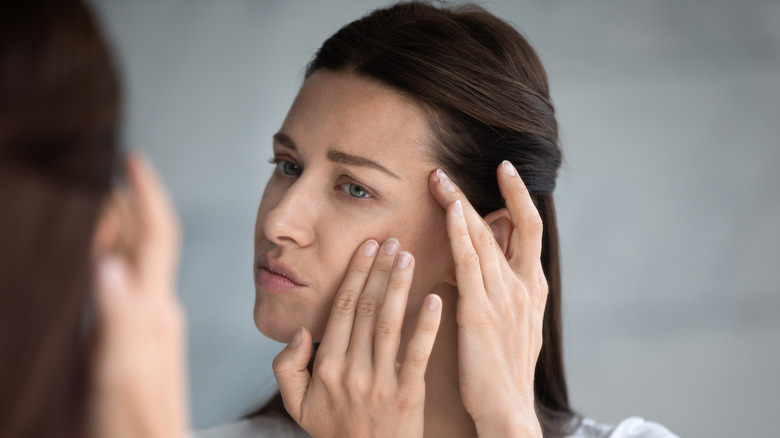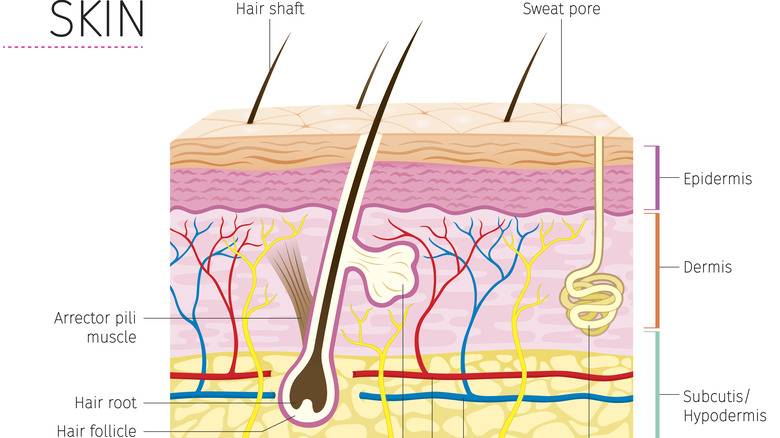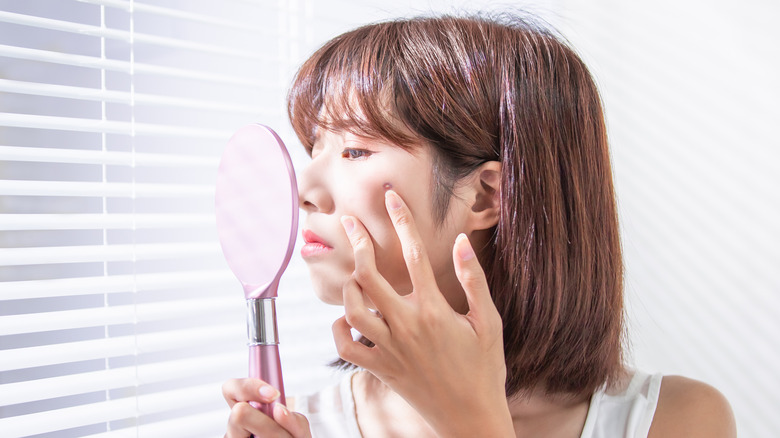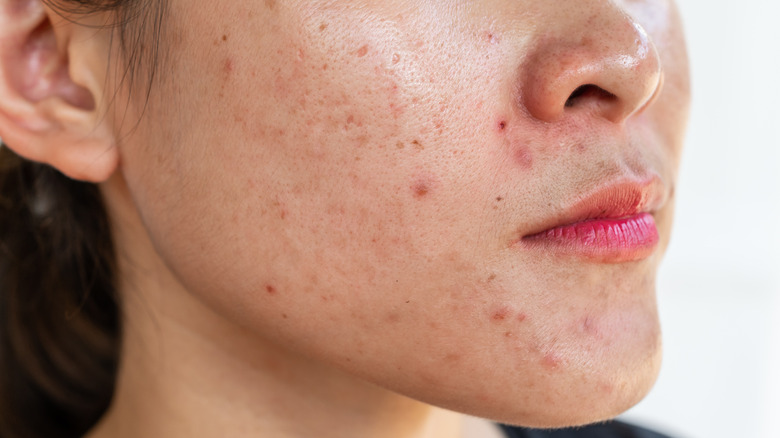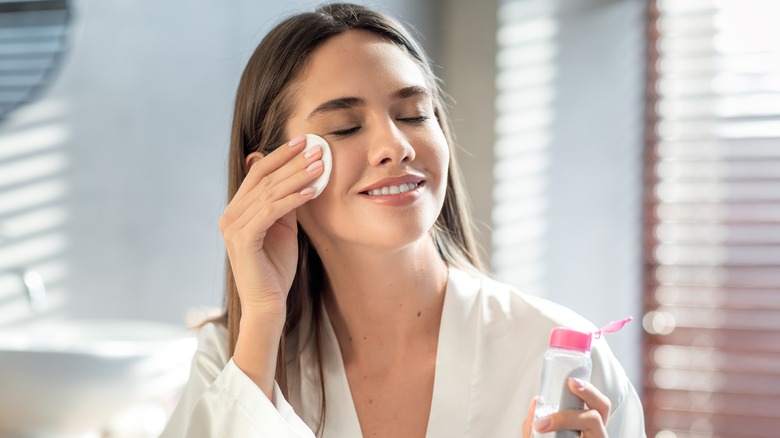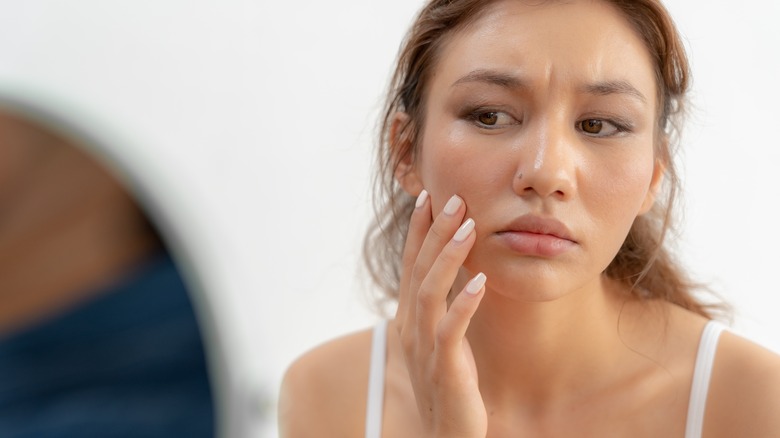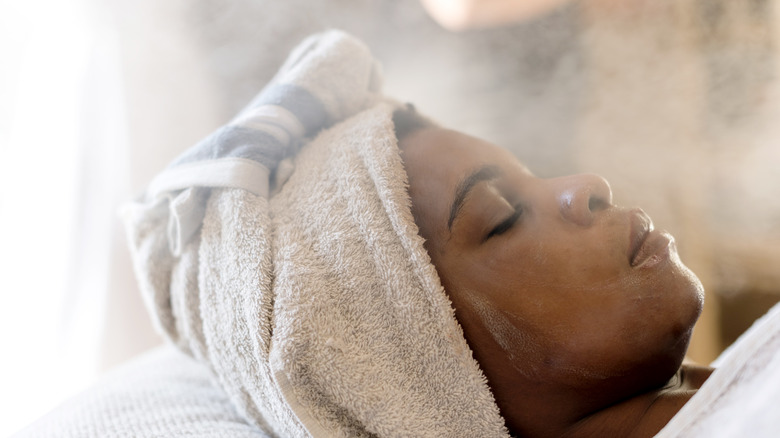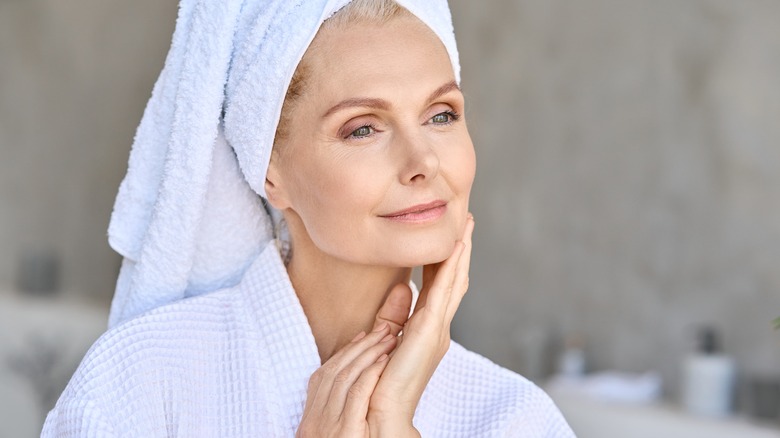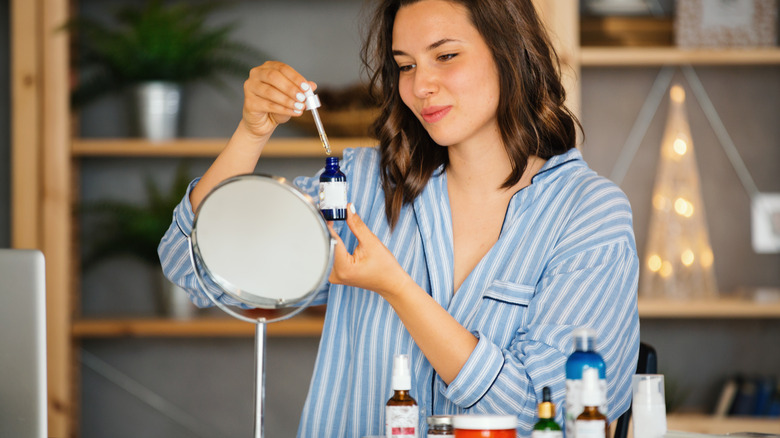Pores 101: Demystifying All The Noise & Getting Straight To The Facts
The skin is an extraordinary and complex organ that many of us are highly invested in. Whether it's for aesthetic or health reasons, understanding these complexities can make a huge difference when it comes to our beauty regimes and skincare. Pores, in particular, do a lot of heavy lifting when it comes to overall skin health, such as keeping our skin moisturized, expelling waste, and even allowing us to regulate our body's temperature through sweat.
Of course, that's just the tip of the iceberg. Pores also play a role in defending against environmental and infectious agents, gas exchange, and reacting in various ways to hormones and nutrition, plus other things we put in our bodies. So it should be no surprise that people may have many misconceptions about what pores actually do and what they don't.
For instance, you might have heard that pores open and close, that whiteheads and blackheads are simply dirt trapped in your pores, or that genetics is the only thing that controls pore size. Here, we tackle these myths and give you the lowdown on how to care for your pores effectively and safely.
What are pores?
We might think of our pores, at least the ones we can see, as openings on the skin's surface. The reality is that what we are actually seeing are small indentations that contain several pore structures, so small that they can't be seen. The pores concerning facial appearance fall into one group called the pilosebaceous unit (per the book "Pathobiology of Human Disease"). These units contain hair follicles, oil glands, and the muscle which causes our hair to contract (i.e., our hair-raising phenomenon –for instance, when cold or surprised).
However, these units are by no means fixed, in that they're neither static in their appearance nor their position within the skin structure. Rather, they extend into various skin layers with a flexible structure that can change or differ due to a variety of influences. For instance, studies described in the Journal of Skin Research and Technology show that hormones, age, gender, genetics, and environmental factors can contribute to changes and differences in these structures from person to person and within a person's lifetime.
Regardless of their structure, however, pores serve the same function for every person. As explained by the Journal of Clinical, Cosmetic, and Investigational Dermatology, the core function of pores is to "ensure the input or output of gasses or fluids," such as sweat, salts (like potassium and sodium), urea (broken down proteins), lactic acid (a product of our metabolic process) and fatty compounds, usually in the form of sebum (our body's natural oils).
Are there different types of pores?
There are two main types of pores — those for sweat and those for oil. Starting with the latter, oil (or pilosebaceous) pores are essentially the openings on the upper layer of our skin, the epidermis, that our hair follicles come out of. However, some research described in the Journal of Immunology and Allergy notes that these pores don't always contain hairs and may appear empty or without fully formed hair, as in the case of enlarged pores commonly seen on the nose.
Oil pores go deep into the dermis, a layer of connective tissue, and are attached to sebaceous glands. The sebaceous glands, according to the book "Physiology, Sebaceous Glands," are small "foamy" sacks where oil or sebum in our skin is produced and stored. As this gland fills with oil, it spills over into the hair follicular area, reaching the skin's surface, which keeps our skin hydrated.
The other pores in our skin excrete sweat (waste) and help to regulate body temperature. These pores are part of the eccrine sweat glands, which are small holes leading to a tubular structure below the dermis that sends water (sweat) to the skin's surface when our temperature increases (per the book "Anatomy, Skin Sweat Glands"). This water then evaporates, creating a cooling effect. Technically, there are also the apocrine sweat glands, though these are typically found around other parts of the body with the exception of the eyelids, where they help to lubricate the eyelashes.
No, clogged pores aren't caused by a lack of cleanliness
Acne and clogged pores aren't due to a lack of cleanliness or hygiene. These factors may help contribute to breakouts, but they aren't the cause. Firstly, clogged pores can take a few different forms, with acne being one of them, which is an inflammatory condition that begins with the growth of acne-promoting bacteria. As explained previously, the sebaceous glands create sebum to lubricate the skin, but pores get clogged when there's too much oil produced.
Why this happens varies from person to person, with the main causes being listed in the Journal of Clinical and Aesthetic Dermatology as hormonal (particularly, high levels of androgen), climate factors like warm or humid weather, genetics, and gender, with those of African descent and males appearing to have higher levels of sebum production. These factors can elicit higher levels of sebum, which can, in turn, make blocked pores more likely, though not always.
Acne develops when dead keratinocytes, the main cells on the surface of the skin (the epidermis), become mixed with sebum, making it stick along the pore channel. When this happens, it becomes a breeding ground for bacteria. Our body tries to fight these bacteria, which triggers an inflammatory response making the area raised and red. The outcomes might be whiteheads, blackheads, cystic, etc., depending on the pH of the skin, the type of bacteria, and how our individual immune system responds (as explained by DermNet).
Can you actually shrink pores?
Firstly, our actual pore size, the size you are born with, changes several times throughout your lifetime, namely due to changes in sebum production. However, when sebum is stable, so is our pore size, and the relative size of pores in an individual is then either determined by genetics or external influences. For instance, the Clinical, Cosmetic, and Investigational Dermatology Journal shows that ethnicity plays more of a role in pore size than aging.
However, how we treat our skin can make pores larger than they actually are. This means that if our pores are enlarged not due to our genetic disposition but external factors, then shrinking them is possible. We know this because certain topical medications are shown in studies (via the Journal of Drugs in Dermatology) to shrink pores.
They obviously won't shrink any smaller than our biology allows, but we can see pore size reduced to what it should be in the first place. For instance, dermatologists in the above study reported that retinol, a vitamin A derivative, reduced pore size significantly. And as dermatologist Dr. Andrea Suarez explains, there are other examples of treatments that can help shrink pores, such as chemical peels like alpha-hydroxy acids (AHAs) and beta-hydroxy acids (BHAs), laser therapy, and antioxidants.
The causes of enlarged pores
So what causes pore size to enlarge in the first place? Research via the British Journal of Dermatology suggests that the main exogenous factors (those originating outside the body) are sun exposure and certain skin care products. The clinical term for such products is comedogenic xenobiotics, and this refers to any synthetic products — those not naturally occurring in nature — that have a high likelihood of clogging pores, which in turn can enlargen pore size.
To decide on whether a product is likely to block pores, many refer to the comedogenic scale (as discussed in the Journal of Cutaneous Medicine). It lists products on a scale of one to five, with five representing those most likely to clog pores, such as those containing silicone, algae extract, and isopropyl isostearate, a moisturizing agent commonly found in skin lotions.
However, given that sebum production is very much hormone-based and that the production of these hormones can be influenced by our diet and lifestyle, we can stipulate that these are also factors that might enlarge pore size. For instance, a 2019 nutritional study in the Journal of Critical Reviews in Food Science and Nutrition highlighted that androgen deprivation therapy, which is the medical or surgical lowering of androgen levels, can also be achieved through a diet with foods high in flavonoids (a compound derived from plants) such as leafy vegetables, fruits, soy and certain beverages like wine and tea.
Why you shouldn't unclog pores yourself
It can be very tempting to try and unclog pores by popping pimples or picking at skin. However, this can do more damage than good. In dermatology, we refer to any skin injuries or infections that can exacerbate an existing condition as sequelae of acne. It's one of the burdensome aspects of treating clogged pores because even after the initial flare-up of a skin condition, it can extend recovery time significantly.
By popping pimples or trying to unclog pores yourself, the American Academy of Dermatology warns, you may inadvertently spread bacteria to other areas of your skin, increasing inflammation, which can prolong an acne blow-up and make the wound worse. In fact, as dermatologist Dylan Alston explains to Intermountain Healthcare, "When you pop a pimple, it can extend the time to 14 or more days before it heals".
Moreover, experts agree that poor acne and clogged pore management leads to scarring in 43% to 90% of cases of acne sequelae, along with a high likelihood of inflammation and rednesses (per the International Journal of the American Academy of Dermatology). Therefore, it's particularly advisable that when your pores are clogged, you resist the temptation of home popping in favor of professional treatments or medications, such as cleansing your face before bed, proper use of exfoliation, or visiting your dermatologist for a proper prescription.
Can you use steam to unclog pores?
You've probably heard that steaming can help to unclog pores by opening them and allowing toxins out. However, according to dermatologist Dr. Whitney Bowe, that's not quite right: Pores cannot open because they don't close to begin with. Although we do have muscles in our skin that allow our hair follicles to contract, pores, as described earlier, are channels or spaces in which fluids and gasses are constantly exchanged.
Therefore, they do not open in response to stimuli like temperature. If we look at the anatomy of the skin (per StatPearl), steam or, more accurately, heat, causes our sweat glands to react by producing more sweat to cool the skin. This might be why we associate steaming with the release of toxins, as sweat is a mechanism for excreting waste. However, this process is separate from that of our oil glands, so if your pores are clogged due to sebum build-up or acne, steaming won't unclog them.
Rather, steaming expands the skin's blood vessels, which can help blood and oxygen circulate through them. However, the research (per the Comprehensive Physiology Journal) is divided on whether this has a positive or negative outcome on overall skin health. On one hand, we see heat improves blood flow, which can help with circulating oxygen and waste drainage. However, it also causes an inflammatory response which, as noted, can make certain skin conditions like acne worse.
Sun exposure can make pores look larger
UV radiation, along with air pollution, is one of the major external instigators of sebum production. Both increase sebum, per the Environmental Science and Pollution Research Journal, but not only that, while sebum typically forms a hydrating barrier on the skin's surface, there's evidence that the skin's barrier itself undergoes a number of changes which this increased level of sebum can't protect against.
This is because UV radiation has the ability to penetrate beyond the upper skin levels, surpassing the epidermis and entering into the dermis, where it can cause a number of structural changes at the DNA level. These effects can trigger a loss of elasticity which is crucial for maintaining the structure of the skin, as well as water loss and premature aging. All of which can enlarge the appearance of pores.
Worse yet, due to the enhanced sebum production, we can suffer from a phenomenon called peroxidation. According to the Journal of Lipids in Health and Disease, researchers have found this to be a precursor to acne, which, as we know, can also increase pore size. Peroxidation is when the lipids or fats in the sebum come under attack by harmful free radicals induced by sun exposure. This starts a chain reaction that changes the environment of the skin, creating a climate suitable for acne bacteria to colonize. In short, sunscreen is a no-brainer.
Pore size changes over our lifetime
As we go through our lives, it's normal to experience times when pores seem larger or smaller. This is because sebum production increases and decreases in response to hormonal changes that happen as we age. The more sebum you produce, the larger pores will be, and vice versa. For instance, we see pores increase at birth when sebum levels are their highest. Sebum levels then stabilize, so pore sizes decrease until puberty. During puberty, sebum levels go up again along with pore size (explaining the unfortunate acne stage). They then stabilize once more before declining during menopause (per the Journal of Clinical and Aesthetic Dermatology).
However, even after this stage, some still experience enlarged pores. Although it's true that genetics plays a greater role in determining pore size than aging, our skin loses collagen as we age, which is fundamental to the structural integrity of the skin's barrier.
This, according to the Journal of Cosmetic Dermatology, is the real reason that pore size appearance changes when we get older, and does not necessarily just relate to hormonal or genetic factors but rather how well we have maintained our skin's barrier over the course of a lifetime. For instance, sun exposure, treatment of the skin, and lifestyle can weaken the barrier over time, leading to elasticity loss, which in turn increases pore size. To safeguard our skin's future, it's essential to begin taking care of it early on with proper skincare maintenance.
The best way to help our pores
Dermatologist Andrea Suarez points to three main factors in pore care, which are sebum levels, loss of elasticity, and hair follicle size. As we've noted, within these categories, there are several internal and external facets. Sebum levels are affected by hormones and lifestyle, loss of elasticity comes from aging and sun exposure, and follicle size is likely to be a component of genetics and skin type (though, of course, it can be a mix).
Everyone's skin is unique, so it's best to target the areas that apply specifically to you to get the best outcome for your pores. For instance, with aging skin, a good approach might be retinoids, which can help to facilitate collagen production and maintain the skin's barrier structure, while also aiding in pore care.
If you have acne-prone skin, it might be worth taking a closer look at your skincare products. Sometimes just having a non-comedogenic label isn't enough to tell if a product will block pores or not, and you may need to do further research. Beta hydroxy acids (BHAs), like salicylic acid, are effective in treating acne by deeply exfoliating the skin. However, those with sensitive skin may experience inflammation, making a gentle alpha hydroxy acid (AHA), like lactic acid, a better option. It's important to choose a treatment based on your specific needs rather than following popular trends or using generic pore treatments that may not be suitable for your skin.
